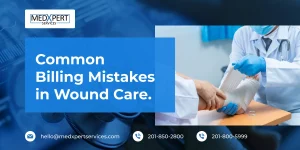Wound care billing is a critical aspect of healthcare administration, yet it remains a difficult and sometimes misunderstood subject. Medicare wound care expenses are expected to range between $28.1 billion and $96.8 billion per year in 2025, emphasizing the importance of correct billing processes. Despite this, many clinicians struggle with the complexities of Current Procedural Terminology (CPT) codes, fearing revenue loss and compliance difficulties.
The constantly changing nature of wound care reimbursement needs a detailed understanding of CPT codes and their use. Incorrect coding can lead to reimbursement denials, payment delays, and even audits. For example, in 2025, the Medicare payment for debridement codes (CPT 11042-11047) increased by 2.5%, proving the importance of exact coding. Furthermore, the payment rate for Disposable Negative Pressure Wound Therapy (dNPWT) in 2025 is $276.57, up from 2024, highlighting the importance of current billing procedures.
This blog aims to provide healthcare physicians, practice managers, medical coders, and billing specialists with a comprehensive guide to wound care CPT codes. Understanding the particulars of these codes and their application enables professionals to improve reimbursement accuracy, compliance, and, ultimately, patient care outcomes.
Understanding Wound Care CPT Codes
Wound Care CPT codes are essential for recording and billing wound treatment procedures. The American Medical Association updates these codes frequently, which are crucial to the reimbursement process.
What Are Wound Care CPT Codes?
Wound Care CPT codes are standardized codes for documenting and billing wound care procedures. These codes cover a wide range of services, including:
- Debridement is the removal of necrotic tissue by surgical or non-surgical procedures.
- Negative Pressure Wound Therapy (NPWT): The use and management of vacuum-assisted closure devices.
- Skin Substitute or Graft Application: The placement of biological or synthetic grafts to repair wounds.
- Topical treatments include enzymatic, autolytic, and medicated dressings.
Importance of Accurate Coding
Accurate coding is essential to avoid claim denials, delayed reimbursements, and potential audits. Key advantages include:
- Correct Reimbursement: Ensures that providers receive the full compensation for the services they deliver.
- Regulatory Compliance: Following CMS and provider requirements reduces the risk of audits and fines.
- Documentation Alignment: Provides claims with clear, thorough records of wound size, depth, kind of debridement, and treatment procedure.
- Efficient Revenue Cycle Management: Assists hospital billing personnel and revenue teams in reducing errors and streamlining claim processing.
Types of Wound Care CPT Codes: Wound Care CPT Code Overview
Understanding the many forms of wound care CPT codes is critical for healthcare clinicians, coders, and billing professionals. This section breaks down the major areas to ensure correct coding and reimbursement.
Debridement Codes
Debridement codes (CPT 97597, 97598, and 11042-11047) are used when necrotic or non-viable tissue is removed from a wound.
| CPT Code | Description | Billing Notes |
| 97597 | Debridement of open wound(s), including topical application(s), wound assessment, whirlpool therapy (first 20 sq cm or less) | Only for necrotic tissue removal. Local anesthesia included. Accurate surface area documentation required. |
| 97598 | Each additional 20 sq cm of debridement | Used with 97597 when the wound exceeds the initial 20 sq cm. Document each additional area treated. |
| 11042 | Debridement, subcutaneous tissue, first 20 sq cm or less | Sharp debridement; deeper than 97597. Document depth and tissue removed. |
| 11043 | Debridement, muscle, first 20 sq cm or less | Deep debridement; document instruments used and wound depth. |
| 11044 | Debridement, bone, first 20 sq cm or less | For wounds involving bone tissue, full documentation of the procedure is required. |
| 11045 | Each additional 20 sq cm of subcutaneous tissue debridement | Used with 11042 for multiple or larger wounds. |
| 11046 | Each additional 20 sq cm of muscle debridement | Used with 11043 for extended areas. |
| 11047 | Each additional 20 sq cm of bone debridement | Used with 11044 when the wound exceeds the initial 20 sq cm |
Wound Care Management Codes
Wound care management codes cover therapies that go beyond debridement. Here are some common examples:
| CPT Code | Descrition | Billing Notes |
| 97602 | Application of dressing(s) to open wound(s) with topical medication(s), including negative pressure wound therapy pump management, per session | Used for wound care management without sharp debridement. Document wound size, type of dressing, and topical agent used. |
| 97605 | Debridement of skin or subcutaneous tissue by mechanical methods (e.g., curettage, dermabrasion), per session | Non-surgical removal of devitalized tissue. Document instruments and methods. |
| 97606 | Instillation of medication(s) into open wound(s) via PICC or CVC, per session | Requires detailed documentation of medication, method of instillation, and treatment rationale. |
| G0281 | Electrical stimulation for wound healing, adjunct therapy | For chronic wounds that do not respond to normal treatments. Document the treatment area, duration, and frequency. |
| 97022 | Whirlpool therapy for wound care | Only billable if not included with 97597/97598. Document necessity and duration. |
Skin Substitute Codes
Skin substitution codes indicate the use of biological or synthetic grafts to aid in wound healing. Key codes include:
| CPT / HCPCS Code | Description | Billing Notes |
| 15002 | Split-thickness autograft, trunk, arms, legs; first 100 sq cm | Document donor site, recipient site, and graft size. |
| 15003 | Split-thickness autograft, each additional 100 sq cm | Use with 15002 for larger grafts. |
| 15271 | Application of skin substitute graft, first 25 sq cm | Includes bioengineered skin substitutes. Document graft type and size. |
| 15272 | Each additional 25 sq cm of skin substitute graft | Use with 15271 when the total area exceeds the initial 25 sq cm. |
| 15275 | Application of skin substitute to chronic wounds | Document wound type, size, and prior failed treatments |
| Apligraf / Dermagraft HCPCS (e.g., Q4100-Q4111) | Bioengineered skin substitute products | Bill using the appropriate HCPCS code. Document wound characteristics, product used, and treatment rationale. |
Modifiers for Wound Care CPT Code
Modifiers for Wound Care CPT Code serve to explain the service offered, resulting in correct claim submission. They represent situations such as several procedures, laterality, or different services.
| Modifier | Use / Description | Example / Notes |
| -LT | Indicates the wound is on the left side of the body | Left leg ulcer debridement |
| -RT | Indicates the wound is on the right side of the body | Right arm pressure ulcer treatment |
| -59 | Special procedural service | Debridement of two separate wounds during the same visit |
| -25 | Significant E/M service on the same day | Evaluation and management were performed with the wound care procedure |
| -GA | Waiver of liability statement on file | Patient has signed ABN for non-covered wound care service |
| -GZ | Item/service expected to be denied as not reasonable/necessary | Used when service is denied due to medical necessity |
| -52 | Reduced services | Partial debridement due to patient tolerance or condition |
| -XU | Unusual non-overlapping service | When the procedure is separate from other wound care codes |
Documentation Requirements for Wound Care CPT Code
Proper documentation is essential for correct billing and reimbursement. This section defines the basic requirements for effectively documenting wound care procedures.
Patient History and Examination
1. Document the patient’s medical history, including any chronic diseases such as diabetes, vascular disease, or pressure ulcers.
2. Record the wound type (acute, chronic, surgical, or traumatic), size, depth, and location.
3. Look for symptoms of infection, discharge, or tissue necrosis.
4. Include any comorbidities that may influence wound healing or treatment decisions.
5. Take baseline images to support continuing therapy documentation.
Treatment Plan & Progress Notes
A clear treatment plan includes the techniques, frequency, and expected outcomes of wound care. It ensures that all steps, from debridement to dressing changes, are justified and consistent with the patient’s clinical demands.
Progress notes document the wound’s healing, reaction to therapy, and any issues that occur. Accurate, dated notes support CPT coding, indicate medical necessity, and lower the likelihood of claim denial.
Billing and Coding Integration
Proper billing and coding integration ensures that wound care CPT codes are consistent with documentation and payer guidelines. Any discrepancy may result in denials or payment delays.
Clear coordination of clinical notes, CPT codes, and modifiers improves claim accuracy. This procedure promotes compliance, reduces audit risks, and helps practices receive timely reimbursements.
Conclusion
Correct use of wound care CPT code is critical to assuring reimbursement and compliance in 2025. Clear documentation, right code selection, and appropriate modifiers help to prevent denials and ensure proper payment. With Medicare spending for wound care anticipated to reach $96.8 billion per year, billing accuracy has never been more important.
For secure revenue, healthcare professionals, coders, and billing specialists must ensure that clinical data are consistent with coding guidelines. An organized strategy not only improves financial outcomes but also ensures that patients receive consistent, high-quality care.
FAQs
What is a Wound Care CPT Code?
A Wound Care CPT Code is a standardized code used to document and bill wound care procedures, ensuring providers receive proper reimbursement.
Why is accurate coding important in wound care billing?
Accurate coding prevents claim denials, reduces audit risks, and ensures healthcare providers are reimbursed correctly for the services they deliver.
What are the common Wound Care CPT Codes in 2025?
Common codes include debridement (97597, 97598, 11042–11047), wound care management (97602–97606), and skin substitutes (15271–15275).
How do modifiers affect wound care billing?
Modifiers clarify details such as laterality, multiple procedures, or special circumstances, helping ensure correct claim submission and faster reimbursements.
What documentation is required for Wound Care CPT Codes?
Providers must record wound type, size, depth, treatment plan, progress notes, and medical necessity with detailed, dated entries to support billing accuracy.
















